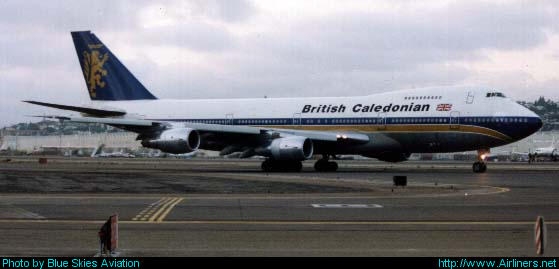PLEASE NOTE: THIS PAGE HAS A LOT OF GRAPHICS.
PLEASE BE PATIENT AS THE PAGE LOADS.
updated 2/15/2000
THE AIRPLANE AND AIRLINES PAGE
(...continued...)
The Boeing 747 (...continued...)


A center fuselage section is lowered into position during
assembly of a 747. The airplane pictured here is an
older 747-200B model, produced in the 1970s.
The world's largest airliner requires the world's
largest building for its manufacture. This is an aerial
shot of Boeing's Everett, WA, complex, north of
Seattle. The huge building in the background is the largest building in the world under one roof and has since
been expanded to accomodate the production of Boeing's new 777 jetliner. The airplanes grouped in the fore-
ground are "on the flightline" (the 747 Delivery Center), meaning they are ready for the customer to pick
up or very nearly so. This facility is also used for delivery of 767 and 777 airplanes as well.

The graceful yet strong design of Boeing's 747 is a marvel of aerodynamic engineering. The aerodynamic force
exerted over one square inch of wing has been described to be as gentle as a baby's breath...yet there is so
much wing area - acres and acres of it - that there is enough force to lift the behemoth into the sky.
As gentle and graceful as the 747 may appear, however, it is built stoutly (a typical Boeing design): the wing
structure is so flexible and solidly built that the wing can flex 27 feet up or down from its neutral horizontal
position before the structure breaks.

LAUNCH!!! A newer Boeing 747-400 lifts
into the sky out of Hong Kong in the
recent paint livery of Cathay Pacific
Airways. In the background can be seen
the tail of another 747 in the previous
paint livery of Cathay. The -400 model can
be distinguished from other 747 versions
by the winglet on the ends of both wing-
tips. If you look carefully at this picture
you can see the ends of the wings flexing
upward (which is normal) as the wings
begin to carry the load of the airplane.
This airplane is powered by four Rolls-
Royce RB211 turbofan jet engines.
The Boeing 727
In the middle 1960s, Boeing embarked on a
bold move to build a medium capacity, med-
ium range airliner unlike anything ever seen.
The resulting airplane, the 727, was, next to
the Douglas DC-3, the most successful comm-
ercial airplane in history. Shown at right
are pictures from the rollout cere-
mony at Boeing's Renton facility of the first
727, a series 100. N7201U, destined for
airline service with United Air Lines.

The initial orders for the first generation 727-100 were
placed by United Airlines and Eastern Airlines. Most
other North American airlines followed with substantial
orders for this airplane and Boeing was backlogged with
orders before the first airplane ever rolled out of the
factory. Airlines from other countries began ordering
the 727 as well, and with the offering of a newer, larger
version, the series -200 (see picture at left, the sales
and production of this airplane far surpassed anything
thathad been produced up until that time. The 727
remained the sales champion of jet airliners until
the 1990s, when the 737 became the sales leader.
A Boeing 727-200 of Delta Airlines arriving in Atlanta.
Go to Site Map
Go to first
(index) page
Go back to
previous page
Send me an
E-mail!!
Go to next
page
Boeing, the Boeing logo and all associated aircraft designs and designations are registered trademarks of The
Boeing Company, Seattle, WA, USA.